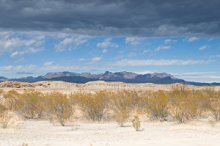Article
Creosote bush, also known as greasewood, is the common name for a genus of bushes known as Larrea. This evergreen bush can be found in hot and dry regions throughout the U.S. Creosote can live up to 100 years and is known for its astringent odor, especially when wet or burning. For many desert dwellers, the scent of wet creosote bush is a scent associated with the summer monsoons, a welcome perfume that can almost overwhelm the senses on a humid afternoon.
"Chisos Mountains and Creosote Bushes" by Louis Vest is licensed under CC BY-NC.
Manuscripts
A01 The Blessing Way (01-07) p. 54
A01 The Blessing Way (01-07) p. 57
A01 The Blessing Way (01-07) p. 100
A01 The Blessing Way (01-07) p. 223
A05 Listening Woman (02-13) p. 32
A05 Listening Woman (02-13) p. 118
A05 Listening Woman (02-13) p. 178
A05 Listening Woman (02-13) p. 183
A05 Listening Woman (02-13) p. 187
References
Castetter, Edward Franklin, and Ruth Murray Underhill
1935 Ethnobiology of the Papago Indians. Ethnobiological Studies in the American
Southwest 4 (3).
Castetter, Edward Franklin, and Willis Harvey Bell.
1942 Pima And Papago Indian Agriculture. Inter-Americana Studies. Albuquerque:
University of New Mexico Press.
Hurd, Paul D., E. Gorton Linsley, and Smithsonian Institution
1975 The Principal Larrea Bees of the Southwestern United States (Hymenoptera,
Apoidea). Smithsonian Contributions to Zoology, no. 193. Washington, D.C.:
Smithsonian Institute.

